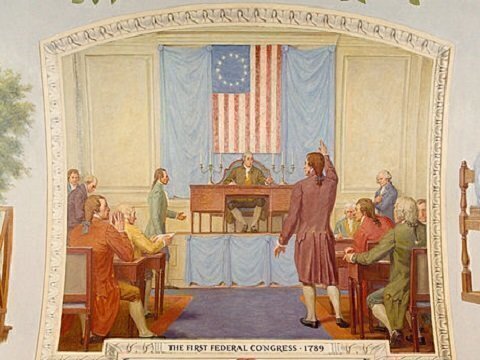On this day in 1789, the First Congress under our current Constitution met in its first joint session in New York and undertook an important order of business: confirming George Washington’s election as President.
 Its predecessors, the Continental Congress, and the Confederation Congress, had met under the Articles of Confederation (and without it) since 1777. The Articles themselves were not fully ratified until 1781.
Its predecessors, the Continental Congress, and the Confederation Congress, had met under the Articles of Confederation (and without it) since 1777. The Articles themselves were not fully ratified until 1781.
The new Congress was set to start functioning on March 4, 1789, in Federal Hall, but bad weather, travel problems, and some hesitation prevented enough Representatives and Senators from arriving in town to conduct joint business for about a month.
The Founders who made it to New York on March 4 met briefly at Federal Hall in the morning, and they realized most of their fellow Congressmen hadn’t shown up for the historic event. On March 11, James Madison and Richard Lee arrived from Virginia, and others soon followed.
But the House had to wait until April 1, when James Schureman of New Jersey and Thomas Scott of Pennsylvania entered Federal Hall and set the quorum needed to appoint House leaders. Frederick Muhlenberg of Pennsylvania was named as the House’s first speaker.
Links: Read The Minutes From The First Congress (House) | (Senate)
The House adjourned again and met briefly as it waited for the Senate to establish its own quorum, with Madison, Lee, Roger Sherman and others writing the House’s rules during the lull.
It took an additional week for four more Senators to show up in New York, and on April 6, the House and Senate took up their first official joint business: convening the Electoral College to confirm George Washington as President and John Adams as Vice President.
In a note from Oliver Ellsworth, the House was notified that the election was underway in the Senate in another room in Federal Hall. Muhlenberg and two other Representatives went to the Senate to monitor the vote count.
Washington received 69 votes, Adams had 34 votes, and John Jay led the runners-up with 9 votes. Under the original election system, each Electoral College member had two votes to cast, and the first- and second-place finishers became President and Vice President.
Madison then appeared in the Senate to state that the House agreed that messages should be sent to Washington and Adams about their election. (The losers were not told of their fate.) Then the House and Senate quickly ended the first session of both institutions. The House also agreed on a constitutional oath that day and the Senate chose a doorkeeper.
The First Congress was arguably the most important of all the Congresses that have met in New York, Philadelphia, and Washington. It approved the submission of the Bill of Rights to the states for ratification; passed a Judiciary Act that set up court systems; defined Cabinet departments; and saw the Compromise of 1790 between Madison and Alexander Hamilton that moved the capital to Washington on the condition the federal government could assume state debts.
Familiar names in the First Congress included Madison, Ellsworth, Sherman, Robert Morris, Fisher Ames, James Monroe, and Rufus King.







